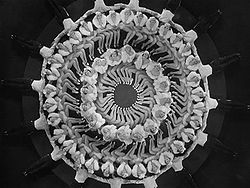One:Holographic dancing: Difference between revisions
mNo edit summary |
mNo edit summary |
||
| (2 intermediate revisions by 2 users not shown) | |||
| Line 1: | Line 1: | ||
Holographic dancing is the stylized movement of one’s body in sync with, in concert/harmony with, or in (intentional) contrast with a holographic display. Although “dancing” implies a rich sonic/melodic background, and although many routines/performances do involve music, holographic dancing refers more specifically to the physical conversation of contextualized movement. | Holographic dancing is the stylized movement of one’s body in sync with, in concert/harmony with, or in (intentional) contrast with a holographic display. Although “dancing” implies a rich sonic/melodic background, and although many routines/performances do involve music, holographic dancing refers more specifically to the physical conversation of contextualized movement. | ||
[http://www.youtube.com/watch?v=xweiQukBM_k/ This performance] is considered one of the early (linear) precursors to holographic dancing. There is continued controversy over the claim that Busby Berkeley’s pieces should be considered authentically influential in the development of holographic dancing, since it was not known at the time that 50-75% of the performers involved were holographic (see also: [[One:Causality Reversal|Causality Reversal]]). | [http://www.youtube.com/watch?v=xweiQukBM_k/ This performance] is considered one of the early (linear) precursors to holographic dancing. | ||
There is continued controversy over the claim that Busby Berkeley’s pieces should be considered authentically influential in the development of holographic dancing, since it was not known at the time that 50-75% of the performers involved were holographic (see also: [[One:Causality Reversal|Causality Reversal]]). | |||
[[File:wheel.jpg|250px|thumb|c|center|Are you my mommy?]] | [[File:wheel.jpg|250px|thumb|c|center|Are you my mommy?]] | ||
| Line 14: | Line 16: | ||
* [[One:Quid Pro Quo Technology|Quid Pro Quo Technology]] | * [[One:Quid Pro Quo Technology|Quid Pro Quo Technology]] | ||
[[Category: | [[Category:What came after]] | ||
[[Category:What came after/Turn H]] | |||
[[Category:What came after/Media]] | |||
Latest revision as of 12:24, 10 December 2012
Holographic dancing is the stylized movement of one’s body in sync with, in concert/harmony with, or in (intentional) contrast with a holographic display. Although “dancing” implies a rich sonic/melodic background, and although many routines/performances do involve music, holographic dancing refers more specifically to the physical conversation of contextualized movement.
This performance is considered one of the early (linear) precursors to holographic dancing.
There is continued controversy over the claim that Busby Berkeley’s pieces should be considered authentically influential in the development of holographic dancing, since it was not known at the time that 50-75% of the performers involved were holographic (see also: Causality Reversal).
Development of high-performance “quid pro quo” technology has permitted the spread of holographic dancing to less wealthy sectors. In fact, lo-definition holographic dancing has proven popular at state and local fairs, due to the dwindling supply of limbic partners.
Links[edit]
Required link to existing article:
Required phantom links:
